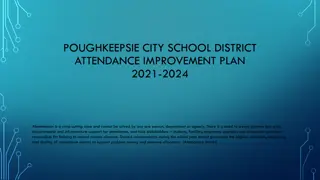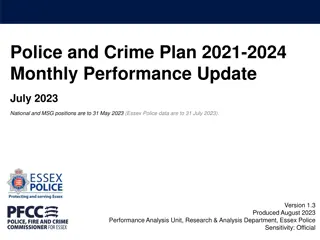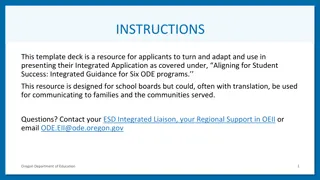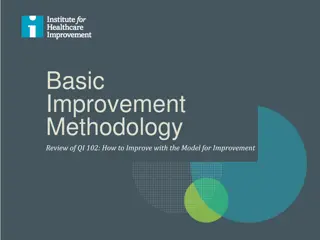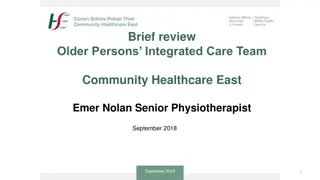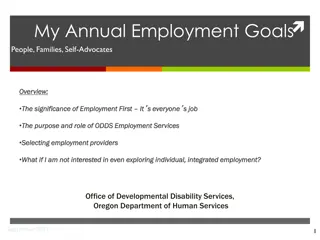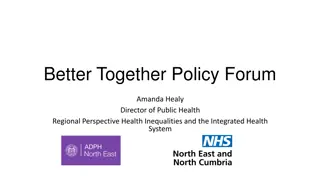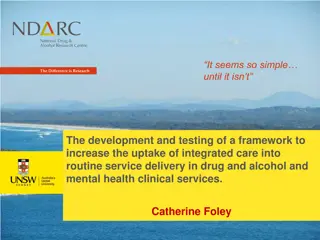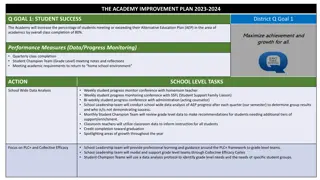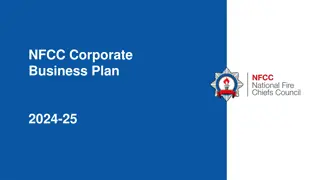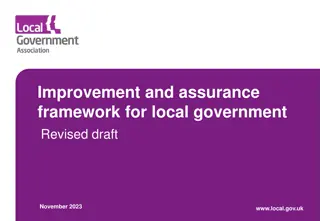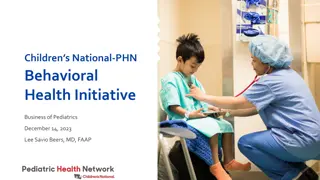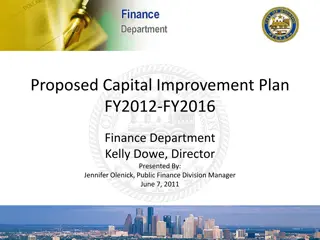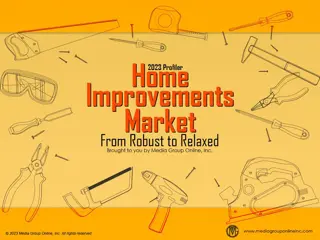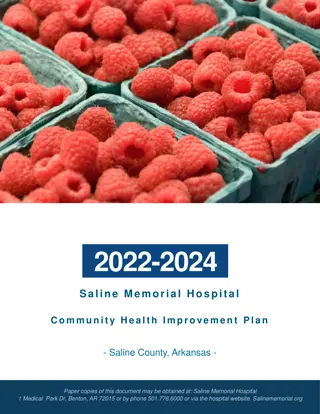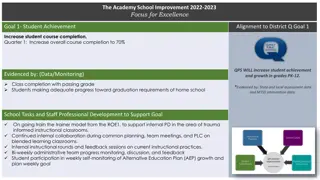Integrated Improvement Plan 2023-2024
The Integrated Improvement Plan 2023-2024 focuses on establishing stable leadership and governance structures, enhancing communication and engagement efforts, and implementing quality improvement methodologies. Key milestones include filling substantive executive leadership positions, developing governance models, and improving communication channels. The plan aims to strengthen risk management, governance, and assurance while contributing to healthcare provider collaborations.
Download Presentation

Please find below an Image/Link to download the presentation.
The content on the website is provided AS IS for your information and personal use only. It may not be sold, licensed, or shared on other websites without obtaining consent from the author.If you encounter any issues during the download, it is possible that the publisher has removed the file from their server.
You are allowed to download the files provided on this website for personal or commercial use, subject to the condition that they are used lawfully. All files are the property of their respective owners.
The content on the website is provided AS IS for your information and personal use only. It may not be sold, licensed, or shared on other websites without obtaining consent from the author.
E N D
Presentation Transcript
Integrated Improvement Plan 2023-2024 May 2023
SRO: CEO 1. Programme Overview: Leadership and Governance C A Success Measures Programme Objectives Stable and substantive executive leadership team in place including an effective executive leadership development plan Effective and transparent corporate governance model supported by an improved accountability framework to strengthen risk management, governance and assurance Structured, systematic and meaningful communication and engagement both internally and externally underpinning the transformation programme. Effective Board oversight and leadership of transformation programme approach with clear Quality Improvement methodology to address culture, safety and teamworking . The Trust makes a full contribution to the East Kent HCP, provider collaboratives & ICS. Substantive executive leadership posts filled by March 2024 (>90%) Successful external Well Led Assessment Identification of risks and effective controls and learning as evidenced in BAF, Risk Management, SI process and triangulation at all levels. Positive executive leadership is reflected in ongoing staff and partner's feedback. Positive feedback on both internal and external communications and engagement. D Project Leads B Projects Andrea Ashman, CPO Recruitment, induction and leadership development plan Caroline Pelly, CNO Governance Model Natalie Yost, DC&E Communications and engagement Ben Stevens, DSD&P Transformation Programme Recruitment programme in place to recruit a substantive executive leadership team Develop and implement a comprehensive executive leadership development plan to support both individual and team development 1.1 Executive Leadership Team E Review and refresh the governance model to be aligned with the organisation restructure and in particular to embed ward to board assurance to support appropriate and timely escalation and embed a culture of on-going learning NOF 4 Exit Criteria contribution 1.2 Governance Executive leadership team posts filled. Executive and Board leadership development plan in place. Trust Board sighted on key risks and actions taken via appropriate escalation. Evidence of effective communication and engagement channels between the frontline and the Board and external partners including escalation of risks. Evidence of Board oversight and leadership of a structured transformation programme approach with a clear Quality Improvement methodology within maternity to address culture, psychological safety and teamworking. Full contribution made to the HCP for East Kent, provider collaboratives & ICS. 1 To develop and implement a clear and consistent approach to internal and external communications and engagement with all our stakeholders to support the delivery of our vision, values aims and strategic objectives. 1.3 Communications & Engagement Develop a structured transformation approach, initially focused on maternity services, with built in Quality Improvement methodology to build a sustainable long-term approach to continuous improvement. 1.4 Transformation Programme 2
1. Leadership and Governance Programme Product Milestones 1. Executive Leadership Team 1.101: Substantive COO in post Apr-23 1.3 Communications and Engagement 1.301: Outline Communications and Engagement Plan published 1.302: Monthly programme of activity including key messages, feedback, quick wins and success stories 1.303 Detailed Communications and Engagement Plan developed, based on feedback received, and rolled out across Trust 1.102: Executive Director induction plans in place and on-going Apr-23 May-23 1.103: Review and refresh Executive Leadership Development Plan Jun-23 May-23 1.104: Current vacant Executive Director posts successfully recruited to 1.105: Critical mass of substantive Executive Directors in post (>50%) 1.106: Executive Team Leadership Development Programme commenced with critical mass in post 1.107: External Well Led Governance Review commissioned with plan to report to Board 1.108 Substantive executive leadership posts filled by March 2024 (>90%). Jun-23 Dec-23 July-23 Dec -23 1.4 Transformation Programme 1.401: Revise Trust organisational structure and launch consultation 1.402: Refocus We Care Programme 1.403: Continue the Cultural and Leadership Programme focus in maternity and review effectiveness 1.404: Develop the Leadership Behavioural Framework 1.405: Develop and adopt the Behavioural Code in Maternity 1.406: Pilot Civility Saves Lives in Maternity 1.407: Introduce a simple tool to assist staff to challenge poor behaviours 1408: Start the leadership programme for team leader, first line, middle manager 1.409: Undertake recruitment to new organisational structure 1.410: Undertake an external diagnostic of board effectiveness Apr-23 Apr-23 Mar 24 Mar-24 May-23 Jun-23 Jun-23 Jun-23 1.2 Governance 1.201: Review and refresh Governance Model to ensure it is aligned with the organisation restructure 1.202: Undertake external diagnostic on Board effectiveness 1.203: Embed Integrated Improvement Plan Governance and Reporting 1.204: QI Oversight/Governance 1.205: Risk Management Training 1.206: EKHUFT New Governance Model Live 1.207: External Well Led Review Completed Jul-23 Oct-23 Dec-23 Jan-24 Jan-24 Mar-24 Apr-24 Jun-23 Jul-23 Aug-23 Autumn-23 3
SRO: CNO&MO 2. Programme Overview: Maternity C A Success Measures Programme Objectives Positive experiences of care reported through Your Voice is Heard Compliance with MDT attendance at handovers/rounds Appropriate senior obstetric oversight for triage Clinical MDT development of action plans Regulatory action plans closed within agreed timeframes Quarterly staff survey reporting that staff feel safe to escalate and report harm Reduction in formal complaints Reduction in the number of repeat incidents with the same causal factors e.g. consultant oversight or failure to escalate Deliver high quality, safe, effective and personalised maternity and neonatal services in partnership with service users. Identify opportunities to learn to continually ensure that women receive the best care for themselves and their babies, that meets their wishes and needs. Embed an inclusive culture where staff feel valued, listened to and supported to deliver patient centred Deliver a safe maternity service that is underpinned by a first-class clinical governance process, to drive and improve the delivery of high-quality person-centred care B Projects D Project Leads Review to Assess: consultant arrangements; roles and responsibilities of senior staff; triage oversight and shift handovers including safety huddles. Review and strengthen existing plans to support safe challenge around behaviours and to build teams that value, support and trust each other 2.1 Team Working Team Working Zoe Woodward, CD, and Director of Midwifery Clinical Escalation &Handover Zoe Woodward, CD, and Director of Midwifery Clinical Assessment & Care Pathways Deputy Director of Midwifery ( 1st May) Governance & Patient Safety Michelle Burrows, Head of Governance Engagement, Listening & Leadership CD, and Director of Midwifery Development of systems and processes to allow staff to recognise deteriorating patients including sepsis management assessment and CTG tools. This will include a review and audit of emergency pathways to ensure these are appropriate and informed by woman s experience. 2.2 Clinical Escalation and Handover Development of care pathways: High Dependency Units, Triage, centralised telephone triage, ANNBS/Sonography, Discharge, and VTE. Focus on SBAR Handover process and escalation processes. Undertake staff surveys to identify barriers and levels of staff confidence to escalate concerns 2.3 Clinical Assessment and Care Pathways E NOF 4 Exit Criteria Contribution Agree quality and safety framework aligned to Trust and national ambitions Ensure there are no backlogs in Patient Safety activities. Learning to be identified and communicated through regular incident learning events and monthly sharing of learning from incidents Evidence of improved and sustained maternity governance process in place. Evidence of improvements in service with clear process for providing evidence of compliance and completed regulatory actions by March 2024. Evidence of improved culture, behaviours, relationships and communications between all relevant teams and frontline staff. 2.4 Governance & Patient Safety 4 Coproduced communication plan to ensure staff feel listened to, and staff receive relevant and timely information. Maternity User Engagement framework aligning to Trust Patient Involvement Strategy. Service will work with partners to develop high quality supported training experiences. 2.5 Engagement Listening & Leadership 4
2. Maternity Programme Product Milestones 2.1. Team Working 2.101: Agree sustainable senior obstetric workforce model in place for triage 2.102: Site based MDT structures embedded and working to implement the quality and safety framework 2.4 Governance and Patient Safety 2.401: No backlogs for SIs. HSIB investigations 2.402: Agree maternity Quality and Safety framework May-23 Sep-23 Jul-23 Aug-23 2.5 Engagement, Listening & Leadership 2.2 Clinical Escalation and Handover 2.201: Demonstrable improvement with fetal heart monitoring guideline compliance 2.202: Embedded quarterly audits supportingappropriate clinical escalation showing improvement; SBAR, MEOWS, sepsis and VTE 2.501: Coproduced plan developed and agreed by staff 2.502: Coproduced (staff and a service users) revised Maternity strategy agreed and communicated 2.503: Coproduced maternity user engagement framework agreed and approved through MVP 2.504: Demonstrable improvement that staff feel listened to (quarterly survey) May-23 Sep-23 Jun-23 ongoing Jul-23 Ongoing 2.3 Clinical Assessment & Care Pathways 2.301: Centralisation of telephone triage 2.302: Agree model and implementation plan for improved discharge pathway 2.303: Agree model and implementation plan for HDU 2.304: Implementation of discharge pathway 2.305: Implementation of revised bereavement pathway 2.306: Agree model and implementation plan for ANNBS/USS/FMU 2.307: Implementation of HDU model 2.308: Embedded quarterly audits supporting appropriate clinical assessment showing improvement SBAR, MEOWS, sepsis and VTE May-23 May-23 Jun-23 Jul-23 Aug-23 Sep-23 Feb-24 Ongoing 5
SRO: COO 3. Programme Overview: Operational Performance C A Programme Objectives Success Measures Trust UEC performance, and the Trust s contribution to the whole system UEC pathway performance, against refreshed local trajectories in line with regional and national standards including: Ambulance handover delays Emergency Department Type 1 (50%) and All Types 4-hour performance (76%) Emergency Department Type 1 12-hour performance and impact of crowding qualitative measures 21-day Long length of stay Trust urgent and emergency care (UEC) performance, and Trust s contribution to the whole system UEC pathway performance, improved and delivery sustained in line with the refreshed improvement trajectories Elective Recovery Plan implemented and recovery sustained against the agreed improvement trajectory to deliver the national elective recovery standards Cancer Performance Plan delivered against the agreed trajectories Elective Recovery performance against agreed local trajectories and national standards including: Eliminate patients waiting longer than 65 weeks Reduce 52 week waits in line with agreed improvement trajectory Deliver OP transformation targets (PIFU 5%/ Virtual appointments 25%/ Reduce follow up activity 25%) Deliver diagnostic stretch target in line with the agreed trajectory B Projects Emergency Care Delivery Group driving internal improvements and ensuring appropriate linkage with whole system interfaces. Scope includes: pre- hospital; Emergency Department; Acute Medicine including SDEC; wards and specialties; ED capital builds; job planning aligned to UEC capacity and demand and engaging with out of hospital/system key interfaces. 3.1 UEC & Whole System Interface Flow Cancer Recovery performance against agreed local trajectories and national standards including: Compliant with Faster Diagnosis Standard (FDS) and 62-day performance Eliminate patients waiting longer than 104 days on the PTL Increased delivery of diagnostic tests within the Buckland Clinical Diagnostic Centre by 25% Implement Straight to Test Services to meet the 28 day Faster Diagnostic Standard 3.2 Elective Recovery (including Diagnostics) Elective Care Delivery Group driving internal improvements including diagnostics, with a focus on the continued reduction of 52ww and P2 patients. Scope to include clinical harm reviews undertaken for all long waiters and job planning aligned to elective capacity and demand. D Project Leads Sandra Cotter, UEC Lead - UEC & Whole System Interface Flow Lisa Neal, Elective Care Lead - Elective Recovery including Diagnostics Sarah Collins, Cancer Lead - Cancer Recovery Cancer Care Group to drive internal improvements to address the backlog and meet the national cancer standards with a focus on the continued reduction of 62 day+ and 104-day patients on the cancer PTL. Scope to include clinical harm reviews undertaken for all long waiters. 3.3 Cancer E NOF4 Exit Criteria Contribution Evidence of an improved grip and realistic refreshed improvement trajectory in UEC whole pathway performance and out of hospital flow, benchmarked both nationally and regionally, by March 2024 aiming to move to 76% floor for all types. Elective recovery plan implemented with evidence of delivery against trajectory and continued reduction in 52ww and P2 patients by March 2024 with elimination of 78 week waits. Sustained improvement in cancer 62-day performance by March 2024. 2 6
3. Operational Performance Programme Product Milestones 3.1 Urgent and Emergency Care (UEC) and Whole System Interface Flow 3.101: WHH Emergency Department Build Phase 3 started 3.102: WHH implementation of the front door clinical model established 3.103: QEQM End of Life Model implemented 3.104: Co-horting wards pathway 1 across WHH/QEQM implemented supported with daily pathway zero reviews, development of board rounds and PTL 3.105: Updated Patient Choice Process rolled out Trust wide (Discharge) 3.106: Direct Access Pathways launched in Acute Medicine, General Surgery & Orthopaedics with training programme for nurse streaming roll out 3.107: QEQM Emergency Department Build Phase 2 started 3.108: UTC new inclusion and exclusion criteria implemented 3.109: MAU Pilot at WHH with access to Short stay Ward, SDEC virtual clinics for acute medicine 3.110: Direct Access Pathways launched in Respiratory, Gastroenterology and Cardiology with hot clinics established in SDEC 3.111: Established pathways to the MDU at KCH (nurse led) 3.112: QEQM Emergency Department Build Phase 3 started 3.113: WHH End of Life Model implemented 3.114: Patient Flow SAFER principles in place across Trust with metrics focussed on discharges by 10.00, golden patients, reduction in 12-hour ED waits 3.115: WHH Emergency Department Build Phase 3 completed 3.116: Critical UEC medical and nurse staffing rotas and job planning in line with the DAP and Dedicated assessment units- business plans 3.117: Bed reconfiguration plan to support establishment of medical and surgical assessment models approved 3.2 Elective Recovery (including diagnostics) 3.201: P2 monitoring report amended to highlight compliance/non- compliance with weekly oversight across each speciality 3.202: Business planning assumptions agreed by executive management team and detailed speciality stretch targets articulated 3.203: Trust Access Policy revised to incorporate clinical review policy and the new Kent and Medway Access Policy 3.204: Outpatient transformation plan re-launched with key milestones and stretch targets for transformation including activity increases (1st OP) and decreases (follow-up) 3.205: Validation plan agreed and implemented for all diagnostic modalities utilising digital transformation available within the Trust 3.206: Actions agreed and implementation started to deliver diagnostics stretch target (tbc) 3.207: Volume of 65-week breaches reduced before December 2023 (in line with winter planning and risk of elective cancellations) 3.208: Eliminate all 65-week patients as per trajectory and ensure 52 week planned forecast delivered 3.3 Cancer 3.301: Clinical harm reviews fully embedded with shared learning and improvement cycle 3.302: Internal improvements in place to meet 62-day compliance 3.303: Internal improvements in place to meet 28-day compliance 3.304: Buckland Clinical Diagnostic Centre increased delivery of diagnostic tests to cancer patients by 25% 3.305: Mobile Cancer Unit increased from 3 to 5 days per week raising awareness whilst providing services to facilitate earlier diagnosis 3.306: Internal improvements in place to deliver the 75% early diagnosis ambition 3.307: No cancer patients waiting over 104 days on the PTL Mar-23 Mar-23 Mar-23 Apr-23 May-23 Apr-23 Apr-23 May-23 Apr-23 Apr-23 Apr-23 Jun-23 Jul-23 Apr-23 Sep-23 May-23 Nov-23 May-23 Jun-23 Mar-24 Jun-23 Mar-23 Aug-23 Sept-23 Aug-23 Sep-23 Oct-23 Dec-23 Oct-23 Dec-23 3.118: QEQM Emergency Department Build Phase 3 completed Dec-23 Mar-24 Mar-24 3.119: A&E four-hour 76% performance delivered Mar-24 7
SRO: CNO&MO/ CMO 4. Programme Overview: Quality & Safety C A Success Measures Programme Objectives Reduction in cases of moderate harm and above for the top 5 recurring incidents, with a month-on-month improvement trajectory for each, and look to switch the KPI aligned to PSIRF later in the year Reduction in the number of repeat incidents with the same causal factors Reduction in Hospital Falls with Harm Reduction in Hospital acquired pressure damage Improvement in KPIs that are within the Fundamentals of Care Framework. Increase in NEWS compliance (escalation process) Reduction in inpatient admissions to ITU related to the deteriorating patient Increase in compliance of safeguarding concerns (KASCFs) being submitted by the care groups within 24hrs of the request from the safeguarding team (KPI on safeguarding dashboard) Reduction in delays in the completion of section 42 investigations increasing & compliance of investigations completed within 30 days (KPI on safeguarding dashboard) Learning framework embedded to support improved early identification and appropriate management of Serious Incidents (SIs) Robust safeguarding sustainability plan in place with continuous improvement programme with the key aim to address gaps in systems and process at care group level through a revised training programme and a new safeguarding competency framework for staff. Refreshed Fundamentals of Care framework focused on key service priorities, aligned to Quality Strategy Improved focus, identification and proactive management of deteriorating patients B Projects Review SI process ensuring alignment to Patient Safety Incident Review Framework to improve early & appropriate escalation with clear accountability Implement the revised SI Declaration Process and enhance clinical engagement Learning to be identified and communicated within and outside the Trust through regular learning events and monthly sharing of learning from incidents 3.1 Quality Governance D Project Leads Delivery of safeguarding sustainability plan with improvement audit cycle Implement training and safeguarding competency framework enabling staff to demonstrate increased understanding and practical application. Implement Safeguarding recommendations from Internal Audit Review sub-contracted safeguarding arrangements as part of quality schedule and oversight arrangements Samantha Gradwell Incident Reporting and Learning Framework Lead Ian Setchfield Deteriorating Patient Lead Wendy Ling - Fundamentals of Care Framework/Ward Accreditation Lead Karen Edmunds Patient Voice and Involvement Lead Pat Hobson Safeguarding Lead 3.2 Safeguarding Develop the Fundamentals of Care Framework to guide priorities and provide assurance that they are integrated into care at all levels of the organisation, enabling the patient voice to be at the centre of services Implement evidence-based revision of ward accreditation programme Implement Patient Voice and Involvement Strategy E NOF4 Exit Criteria Contribution 3.3 Fundamentals of Care Evidence of an improved process based on best practice and in accordance with framework standards for the management of serious incidents with evidence of delivery, leadership and learning from incidents, reflecting a single approach which aligns to the Trust governance process. Evidence of sustained improvement in safeguarding compliance with the NHS Safeguarding Accountability and Assurance Framework 2022 overseen by the Trust Board, including oversight of any sub-contracted activity with continuous cycle of review, assessment and implementation of best practice and learning. 3 Design and deliver a continuous improvement programme using a safety improvement coaching approach to improve the timely recognition, escalation and response to identify the deterioration patient NEWS 2 e-learning module, deteriorating patient education programme, deteriorating patient dashboard, CQUIN NEWS2 3.4 The Deteriorating Patient 8
4. Quality & Safety Programme Product Milestones 4.3 Fundamentals of Care 4.301: Review current FOC workstreams and develop FOC framework 4.302: Review and refresh Pressure Ulcer/Falls/Nutrition delivery plans 4.303: Develop dementia strategy delivery plan & associated KPIs 4.304: FOC confirmation of metrics 4.305: Learning Session 1 Nutrition 4.306: Learning Session 1 Falls 4.307: Learning Session 1 Pressure Ulcers 4.308: Learning Session 2 Falls 4.309: Learning Session 2 Pressure Ulcers 4.310 Learning Session 2 Pressure Ulcers 4.311: FoC Metrics Deep-dive Review and Refresh 4.1 Quality Governance 4.101: Define roles and responsibilities to promote senior clinical engagement and leadership 4.102: Develop new cross Trust Patient Safety Incident Response systems and processes (replacing current SI process), including beginning to share the learning from SIs 4.103: EKHUFT SI Learning Framework Designed 4.104: Commence transitioning across to the new PSIRF 4.105: Board BAF & Risk Management Session 4.106: EKHUFT SI Learning Framework Implemented 4.107: Patient Safety Incident Response Plan Implementation May-23 June-23 June-23 July-23 Sept-23 Oct-23 Nov-23 Jan-24 Jan-24 Feb-24 Mar-24 Apr-23 May-23 Jun-23 Aug-23 Oct-23 Nov-23 Feb-24 4.2 Quality 4.201: Review and refresh current sustainability safeguarding plan 4.202: Finalise sustainability safeguarding team business case and take through Trust business planning process 4.203: Revised training and competency framework approved by safeguarding committee 4.204: Set up task and finish group with oversight through safeguarding operational group 4.205: Implement revised level 2 training for international nurses 4.206: Implement new safeguarding competencies for international nurses 4.207: Commence roll out of competencies for all staff 4.208: Audit of effectiveness of training and competency-based framework 4.209: Review sub-contracted safeguarding arrangements as part of quality schedule and oversight arrangements April-23 4.4 The Deteriorating Patient 4.401: Agree with ICB the required funding for Patient safety specialist role and Improvement Project 4.402:Confirm The Deteriorating Patient Safety Improvement Project building on current Trust improvement capacity 4.403: Launch NEWs-2 e-learning module 4.404: Commence roll out of deteriorating patient education programme 4.405: Deteriorating Patient Dashboard developed and shared with care groups April- May 23 Mar-23 April-23 June-23 May-23 April-23 May-23 May-23 Jul-23 Jul-23 June-23 June -23 June -23 9
SRO: CPO 5. Programme Overview: - People and Culture C A Success Measures Programme Objectives Improved National Staff survey (YOY trend) / Pulse data (1/4ly trend): increased response rate, engagement and staff recommending EKHUFT as a place to work Improved National Staff survey (Manager questions YOY trend) Improved Culture dashboard monthly data trends Improved WRES / WDES / F2SU data Improved Appraisal Conversation completion rates Leadership development (Development plan + 360 feedback Board to HLT) Improved Well Led domain CQC rating (date tbc) Improved People Metrics / KPI s (recruitment, vacancy rate, retention, job planning, /pipelines, disciplinary s and sickness rates) Listening Sessions/Anecdotes / staff live feedback Pastoral Care award Development of and improved performance against medical workforce dashboard Job planning and PA review completed by May 2023 Specialist registration (CESR) programme to be expended and rolled out. Design & Embed NHS s Culture & Leadership Programme within EKHUFT to make EKHUFT a Great Place to Work & Learn. Deliver tactical task and finish work to drive improvements to key metrics, e.g. appraisal, rostering compliance and visibility of job-planned hours Develop an attraction and retention strategy to deliver a sustainable workforce Improving attendance toolkit to be used to assess and generate outcomes for an improved sickness rate Collation and monitoring of recruitment and training trajectories for IENs and HCSWs inclusive of training date for OSCE and ready to care to ensure that colleagues are ward ready and trained. B Projects D Strategy developed alongside workforce plans by speciality in correlation to the clinical adjacencies programme. Attendance and collaboration as a Kent and Medway partnership. Dashboards built to support People and Culture KPIs. Project Leads 5.1 Attract and Retain Andrea Ashman, Chief People Officer Rita Lawrence Programme Director, Culture & Leadership Programme Rebecca Martin Chief Medical Officer Strategic, group wide transformation project to engage the workforce in designing embedding a new culture within EKHUFT, through initiatives such as Culture Leadership programme, behaviour framework, Pulse Survey Reviews, Embedding Culture Dashboard, EDI Strategy & Plan and embedding a Culture Change Team within trust E NOF 4 Exit Criteria Contribution 5.2 Culture and Leadership Evidence of staff and user involvement in and feedback on specific improvements . Improved staff engagement and Trust leadership in line with national/peer/ICS. Staff sickness and vacancies tracked and reduced so Trust not an outlier across ICS. Improved retention and turnover rates for all staff groups and sustained improvement in vacancy rate trajectory in hard to recruit specialties. International nursing and Clinical Support Worker recruitment trajectories agreed and evidence of delivery against these by March 2024. 5 Tactical task and finish work to develop dashboards demonstrating improvement in key medical workforce metrics, e.g. appraisal, training compliance, rostering compliance, visibility of job-planned hours etc. Medical attraction and recruitment programme plan and working group in place. 5.3 Medical workforce 10
5. People & Culture Programme Product Milestones 5.3 Medical Workforce 5.301: Medical attraction programme plan developed for fragile clinical services 5.302: Digital and social media targeted recruitment 5.303: Dashboard for medical attraction and trends built 5.304: Rostering trial 5.305: Medical Job Planning assessment of levels of attainment and trajectory developed to reach level 4 5.306: Specialist Registration (CESR) programme development 5.307: Pastoral Care for all international recruits 5.308: Development of a medical workforce dashboard 5.3.09: Development of GMC survey dashboard 5.3.10: Review of clinical digital induction 5.1 Attract and Retain 5.101: Recruitment trajectories produced and progress monitored for IENs and HCSWs 5.102: Workforce specialty developed plans linked to clinical adjacencies 5.103: Workforce strategy inclusive of recruitment strategy developed and communicated 5.104: Absence audit completed with analysis of outcomes 5.105: Pastoral Care award 5.106: Nursing pipeline plan developed 3-5 years 5.107: NHSE absence tool 5.108: Appraisal quality reviews Jun-23 Jun-23 Jun-23 Sep-23 May-23 Jun-23 Jun-23 Jun-23 Jun-23 Jul-23 Jul-23 Jul-23 Sep-23 Sep-23 Sep-23 Sep-23 Sep-23 Sep-23 5.2 Culture & Leadership Development 5.201: Launch of New Starter Experience survey 5.202: Development of enhanced NSS dashboard 5.203: Launch of new Benefits platform & EAP 5.204: Publication of enhanced NSS dashboard 5.205: Promote & communicate 5.206: Thematic analysis of NSS free-text comments 5.207: Review of We Care progress through NSS data 5.208: Behavioural framework created 5.209: Culture & Leadership Development rolled out Trust wide 5.210: Define EDI Strategy & Plan 5.211: Effective succession planning and cycle established Jan-23 Jan-23 Feb-23 Mar-23 Mar-23 Apr-23 Apr-23 Jun-23 Jul-23 Jul-23 Jul-Dec-23 11
SRO: CFO 6. Programme Overview: Financially Sustainable C A Success Measures Programme Objectives Review of the whole financial governance aligned to organisational restructure including appropriate agreed oversight, assurance and performance management to support budget holders to deliver Financial Improvement Oversight Group (FIOG) well attended and discussing and progressing full range of productivity and efficiency improvements. Regular review of key financial oversight mechanisms to ensure efficacy. Three-year FRP developed reflecting engagement with key stakeholders and agreed as credible. Two consecutive quarters of Year 1 3YP run-rate delivered Improvement over the year in underlying financial run rate. Programme of regular communications and engagement underway with Trust staff relating to finance, productivity, and efficiency. Achieve financial sustainability within the ICS financial envelope through the design and delivery of a Three-Year Financial Plan Enable and embed sound financial `governance and practice from ward to board. Create a multi-year productivity and efficiency programme across care group and pathways. Improve financial consciousness across the organisation through the development and roll out of a financial and efficiency communications strategy. Drive financial sustainability alongside planned trajectory to reduce carbon footprint. B Projects Project to embed strong financial governance, productivity and efficiency delivery governance across the organisation. Reinstate and embed financial training 6.1 Financial Governance D Project Leads Michelle Stevens Interim Chief Financial Officer Ann Johnson Financial Improvement Director Develop a Three-Year Plan to move EKHUFT to a sustainable financial position. Establish a Financial Improvement and PMO infrastructure to increase the amount of recurring CIP delivered. Articulate the ask and potential EKHUFT opportunity from the East Kent . 6.2 Financial Improvement E NOF4 Exit Criteria Contribution Project to engage staff on the financial challenge the Trust faces and the productivity and efficiency opportunity available to the Trust through making the most of our money for patients. Agreed Financial Recovery Plan in place supported by clear evidence base, approved by the board and compliant with agreed trajectories Evidence of improved delivery against plans, trajectories and envelopes The Trust fulfils its statutory duties with regard to financial management Robust oversight, financial controls and processes are in place and overseen through appropriate financial governance procedures Benchmarks well against model hospital efficiencies or has agreed trajectory. The trust and system have a shared understanding of risks to the financial plan and have agreed mitigations in place Control the costs of overseas recruitment against plan 6.3 Financial Consciousness 6 12
6. Finance Programme Product Milestones 6.1 Financial Governance 6.101: Implement Financial Improvement Oversight Group 6.102: Effective Care Group oversight approach in place 6.103: Embed monthly finance reviews with Care Groups 6.104: SFIs definition & refresh 6.105: Meeting structure and review of TOR 6.106: Review, relaunch and embed Strategic Investment Group (SIG) 6.107: Budget Holder training restarted and embedded 6.108: Rebasing to revised hospital structure 6.109: Joint Trust and ICB action plan re. Financial Recovery Plan (FRP) Development 6.3 Financial Consciousness 6.301: Implement Clinical Leaders Efficiency Group (CLEG) to engage clinicians in productivity and efficiency, followed by a review of the approach 6.302: Update financial and efficiency communications strategy 6.303: Regular communications on finance and efficiency 6.304: Regular updates to and oversight by FPC & FIOG Mar-23 Jun-23 Jun-23 Jul-23 Jul-23 Aug-23 Sep-23 Sep-23 Ongoing Mar-23 Mar-23 Ongoing Ongoing 6.2 Financial Improvement 6.201: Develop and agree FRP core base year (FY24) 6.202: Update deficit drivers analysis 6.203: Model years one and two of FRP 6.204: Update FRP document 6.205: Fully develop FY24 efficiencies 6.206: Identify and prioritize development of harder to achieve improvements 6.207: Develop multi-year productivity and efficiencies approach covering pathway improvement and GIRFT 6.208: Review and sign off including FRP base year Q1, Q2 and Q3 reviews 6.209: Review and sign-off FRP including: Trust and ICB sign off and FRP progress quarterly reviews 6.210: Input to Kent and Medway System Finance Work Mar 23 May-23 Jun-23 Jun-23 Jul- 23 Jul-23 Jul-23 Jan-24 Jan-24 Ongoing 13




